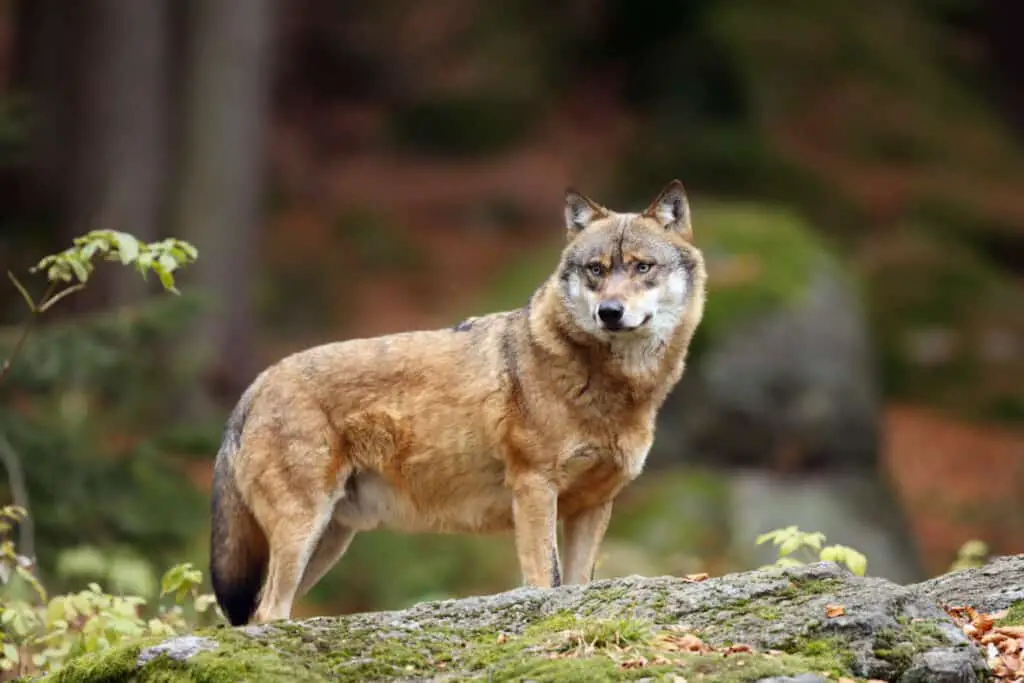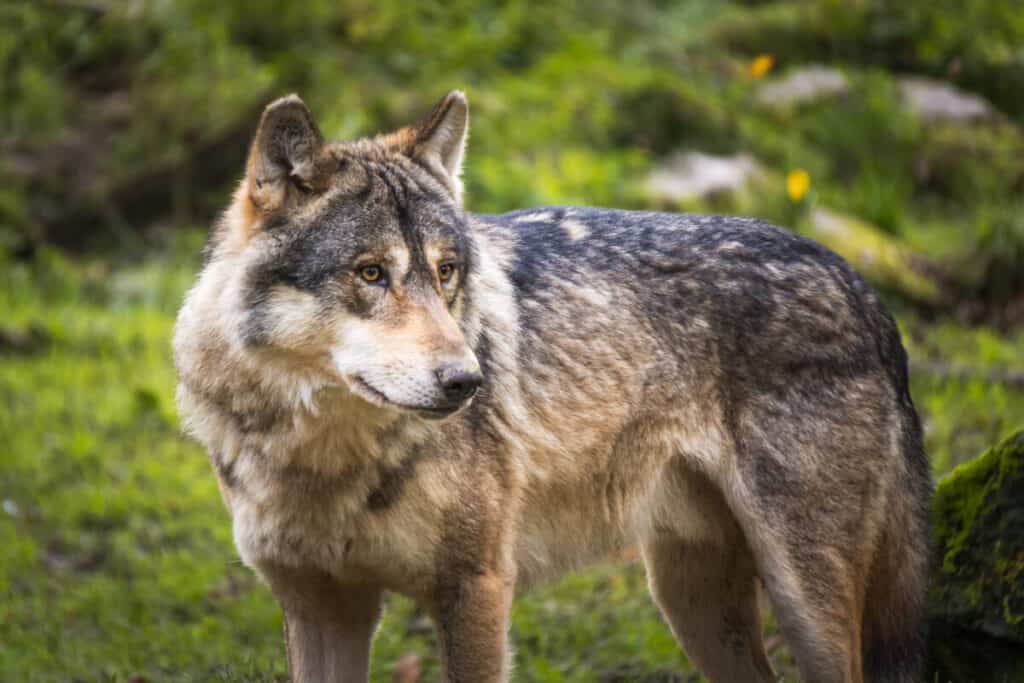The Eurasian wolf, also known as the gray wolf or Canis lupus lupus, is a large and powerful predator that has inhabited much of Eurasia for thousands of years.
These wolves are highly adaptable and have been able to thrive in various environments, from dense forests to open grasslands.
Eurasian wolves typically weigh between 60-100 pounds and stand at around two feet tall at the shoulder.
They have thick fur coats that can range in color from grey to brown, with black markings on their faces and tails.
Despite being widely feared by humans due to their reputation as ruthless hunters, these wolves play an important role in maintaining ecological balance within their ecosystems.
However, human activities such as habitat destruction and hunting have led to significant declines in Eurasian wolf populations throughout much of their range.

Habitat And Range Of The Eurasian Wolf
The Eurasian wolf, also known as the gray wolf or Canis lupus lupus, is a highly adaptable species that has managed to maintain its presence across large parts of Europe and Asia.
Although their habitat ranges from arctic tundras to hot deserts, these wolves are most commonly found in forested areas with access to water sources.
Despite being widely distributed throughout their range, there have been instances where the Eurasian wolf population has dwindled due to human activity such as hunting.
Migration patterns play a crucial role in maintaining healthy populations of the Eurasian wolf.
These wolves travel long distances annually in search of food and suitable breeding grounds.
As apex predators, they help regulate prey populations which subsequently impacts the ecosystem at large.
However, changes in migration patterns due to climate change or human interference can affect not only these wolves but other species who depend on them for survival.
Therefore, understanding the ecological impact of this fascinating animal is essential for conservation efforts aimed at preserving both wolves and their habitats.
Physical Characteristics Of The Eurasian Wolf
The Eurasian wolf is the largest subspecies of gray wolves and has distinct physical characteristics that set it apart from other wolf species. It possesses a thick fur coat, which can vary in color ranging from reddish-brown to black, with white markings on its chest and underbelly. They have strong jaws, sharp teeth, and powerful legs that enable them to run at high speeds for extended periods.
Behavioral patterns of the Eurasian wolf are also noteworthy. Being highly social animals, they live in packs consisting of family members led by an alpha male-female pair. Wolves use their body language to communicate with each other; tail position, ear placement, and facial expressions all play a crucial role in conveying information within the pack. Furthermore, howling is another significant form of communication used by wolves both inside and outside their territories.
Cultural significance:
- The image of the wolf is often associated with bravery.
- In some cultures, people believe that seeing a lone wolf signifies impending danger or death.
- Stories about wolves feature prominently as characters in many folk tales worldwide.
- The act of hunting these creatures was seen as a rite of passage among indigenous peoples living near wolf habitats.
Overall, understanding the physical characteristics and behavioral patterns of the Eurasian Wolf provides valuable insight into this fascinating creature’s life cycle. Its cultural significance highlights its importance not only biologically but also culturally across different societies throughout history.
Diet And Hunting Behaviors
The Eurasian wolf’s physical characteristics enable it to excel as a predator. Its strong jaws and sharp teeth can easily crush bones, allowing it to consume its prey entirely. Additionally, the wolf has excellent senses of hearing, vision, and smell that allow it to detect prey from afar. The wolf’s fur also helps protect against harsh weather conditions such as extreme cold.
In terms of diet and hunting behaviors, the Eurasian wolf is an opportunistic hunter with varied prey preferences. It primarily feeds on large ungulates such as moose, deer, and wild boars but will also hunt smaller mammals like hares or rodents if necessary.
The wolf uses pack hunting strategies where members work together to take down larger prey by surrounding them and attacking vulnerable areas like the neck or legs. These tactics require coordination among pack members which contributes to their high success rate in hunting.
Social Structure And Communication
The social structure of the Eurasian wolf is complex and fascinating. These animals are known for forming packs, which can consist of anywhere from 2 to 30 individuals. Within each pack, there is a strict hierarchy based on age and dominance.
Alpha wolves lead the pack, followed by beta wolves who serve as second-in-command. The rest of the pack falls into various subordinate roles.
Pack dynamics play an essential role in communication among Eurasian wolves. Members communicate with one another using a variety of vocalizations that convey different meanings depending on the situation.
For example, howls are used to locate other members of the pack and signal territorial boundaries, while growls and barks may be used during confrontations or hunting activities.
Understanding these vocalizations is crucial for maintaining group cohesion and ensuring successful hunts.
Conservation Status And Threats
The Eurasian wolf is currently classified as a species of ‘Least Concern’ by the International Union for Conservation of Nature. However, certain populations in specific regions are facing an endangered status due to various threats such as habitat loss and fragmentation, hunting, and poaching. Due to their large range across Europe and Asia, conservation efforts must be tailored to each region’s unique circumstances.
Poaching has been identified as one of the most significant threats to Eurasian wolves in many areas. In some countries, illegal hunting is driven by the demand for wolf pelts or body parts used in traditional medicine. Additionally, wolves may also be killed because they are seen as a threat to livestock or human safety.
To address this issue, effective poaching control measures must be implemented along with education campaigns aimed at changing attitudes towards these animals. Furthermore, initiatives that encourage coexistence between humans and wolves could reduce negative interactions and ultimately lead to better long-term conservation outcomes.

Human-Wolf Interactions And Conflicts
Having discussed the conservation status and threats surrounding Eurasian wolves, it is important to examine human-wolf interactions and conflicts.
As an apex predator, wolves have been known to attack humans in rare instances. However, these incidents are often a result of habituation caused by human interference with wolf behavior and territory.
In areas where wolf populations have declined due to hunting or other factors, reintroduction programs have been implemented as a means of restoring ecological balance. These programs aim to reduce potential conflict between humans and wolves through proper management strategies such as monitoring population sizes and educating local communities.
Despite efforts to mitigate conflicts, wolf attacks on livestock continue to be a major issue for farmers and ranchers in many parts of the world. Although compensation schemes exist in some regions, they may not always provide sufficient support for those affected by losses from wolf predation. Additionally, tensions arise over differing perspectives on land use and wildlife management practices.
It is crucial that stakeholders work together towards finding solutions that benefit both humans and wolves while also recognizing the importance of biodiversity conservation. With careful planning and communication, it is possible for humans and wolves to coexist harmoniously within shared landscapes.
Without question, much more research needs to be done on the complex relationships between people and wild animals like Eurasian wolves. Further understanding can only help us make better decisions about how we manage our natural resources going forward – especially given increasing pressures from climate change effects on ecosystems around the globe today!
Conclusion
The Eurasian wolf is a remarkable and fascinating creature that inhabits vast areas of Europe and Asia. It has adapted to various habitats, ranging from forests to deserts, and possesses impressive physical characteristics that enable it to survive in harsh environments.
The species plays an essential role in the ecosystem as apex predators, controlling populations of herbivores such as deer and wild boar. Eurasian wolves live in packs with complex social structures, where communication is vital for their survival.
Unfortunately, human activities such as habitat destruction, hunting, and persecution have led to significant declines in their population. Conservation efforts are crucial to ensure the continued existence of this magnificent animal.
As the saying goes, ‘We do not inherit the earth from our ancestors; we borrow it from our children.’ Therefore, it is our responsibility to preserve biodiversity by protecting endangered species like the Eurasian wolf.
In conclusion, understanding the biology and behavior of the Eurasian wolf can help us appreciate its importance in maintaining ecological balance. Conservation measures should focus on mitigating conflicts between humans and wolves while promoting coexistence through education and sustainable land use practices.
By working together towards common goals, we can secure a future for both wildlife and humanity alike. Remembering another adage – ‘United we stand; divided we fall’ – emphasizes how important collaboration is when dealing with conservation challenges globally.

